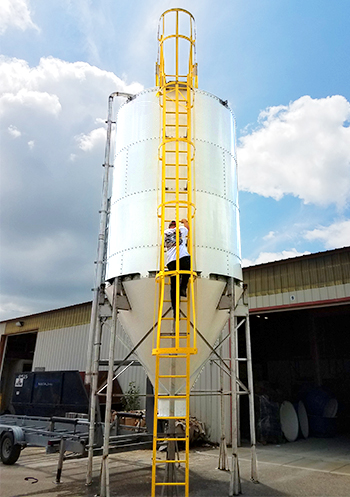Case Study: SAFRAIL™ Goes Vertical for Storage Tanks

Tanks and silos are designed to handle the rigors of chemical storage and dry goods. The materials to construct these structures are heavily influenced by environmental and structural variables.
For over 30 years, Fiberdome Incorporated has been a leading builder of fiberglass tanks and silos ranging from 6' to 12' in diameter serving the dry bulk storage market.
When one of their design-to-build projects required specific weight tolerances, the engineers from Fiberdome turned to Strongwell's SAFRAIL™ Ladder and Cage systems. Since the 1950s, SAFRAIL™ Fiberglass Ladders and Cages have been a common sight as wall mount ladders, base/floor mount ladders, walk-through ladders with return, side mount cages, and walk-through cages with return.
Upon the completion of the tank, Strongwell’s Chatfield facility fabricated and shipped a SAFRAIL™ Ladder System measuring 31'-2" in height. To gain access into the hatch of the tank, a sloped 42" x 42" SAFRAIL™ Industrial Handrail system was designed to accommodate elevated tank stairs. Both systems were pultruded with a premium polyester resin with an OSHA safety yellow pigment.
| TECHNICAL DATA |
|---|
| Product: Storage Tank Access Ladder and Handrail |
| Process: Pultrusion, Fabrication |
| Materials & Sizes:
SAFRAIL™ Industrial Handrail System SAFRAIL™ Ladder & Cage System |
| For: Fiberdome Inc. |
Manufactured in Chatfield, Minnesota, SAFRAIL™ ladder and handrail products provide structural access materials for process vessels, tanks, walkways, and railways within industrial and chemical facilities where weight, safety, and corrosion are issues of concern. The ladder and cage systems can be highly customized in their design, manufactured with NSF certified materials upon request, and are approved for use by the American Bureau of Shipping.
Both the end-user and Fiberdome were thoroughly pleased with the overall design and product functions upon delivery and setup.